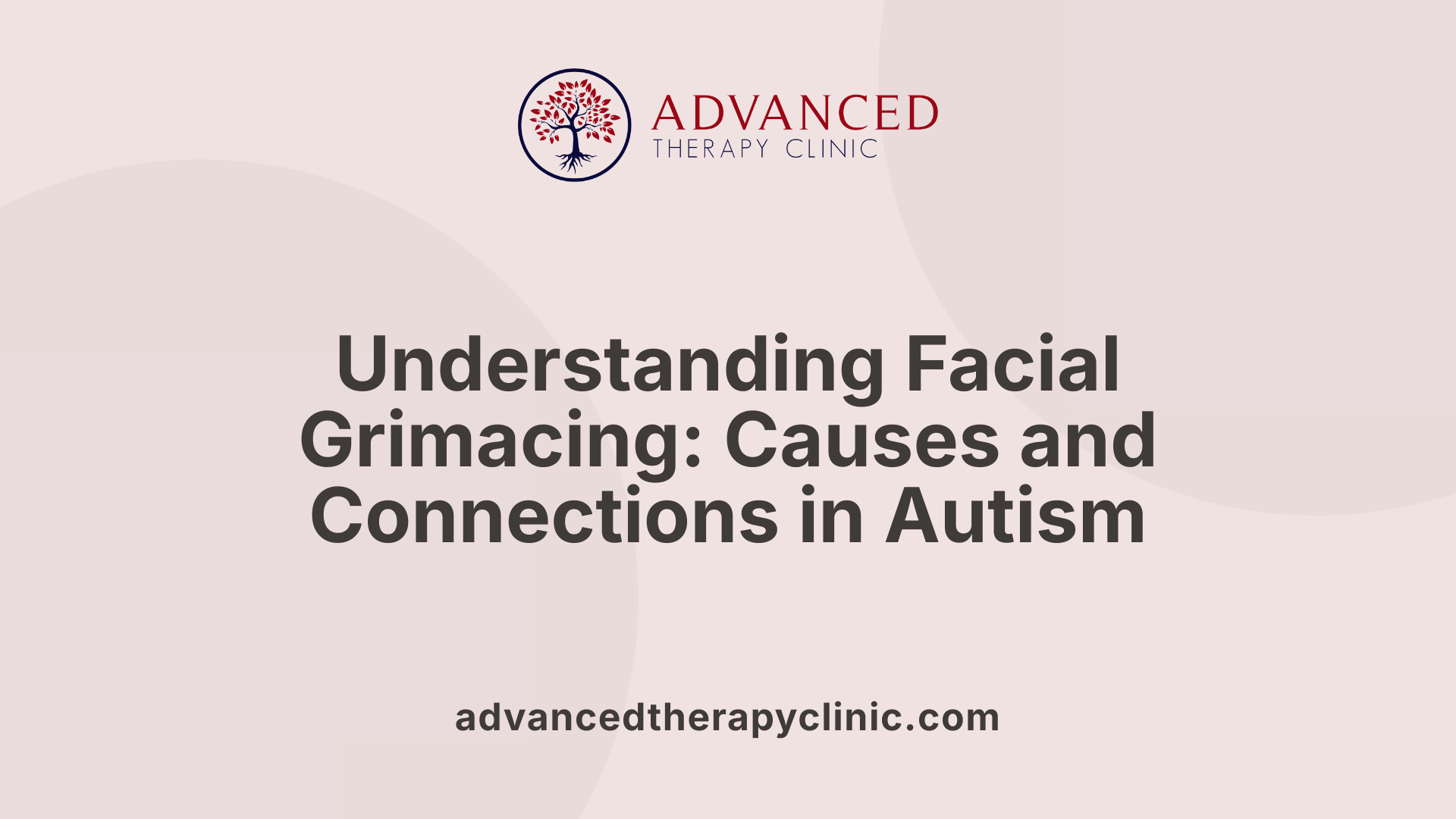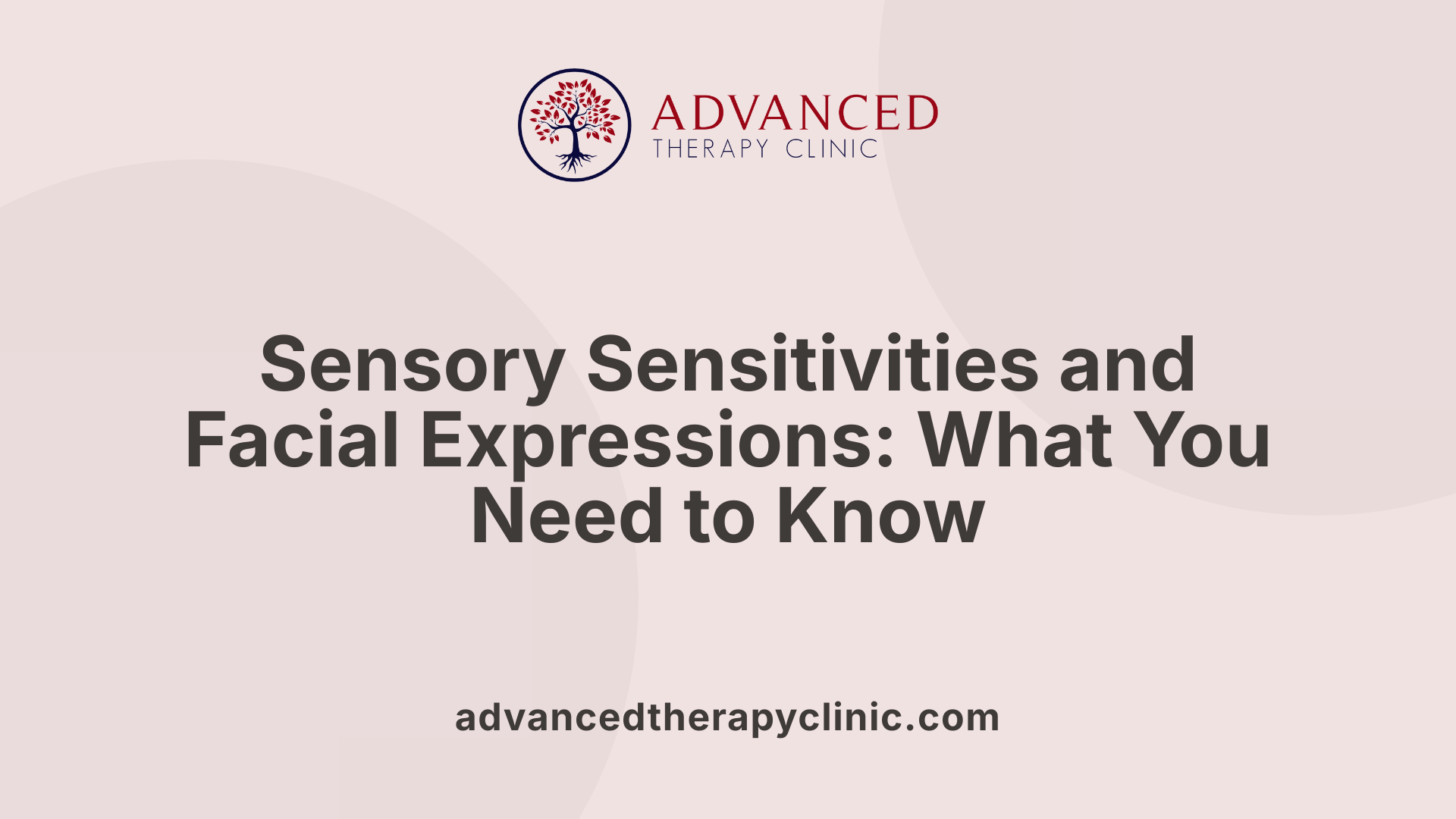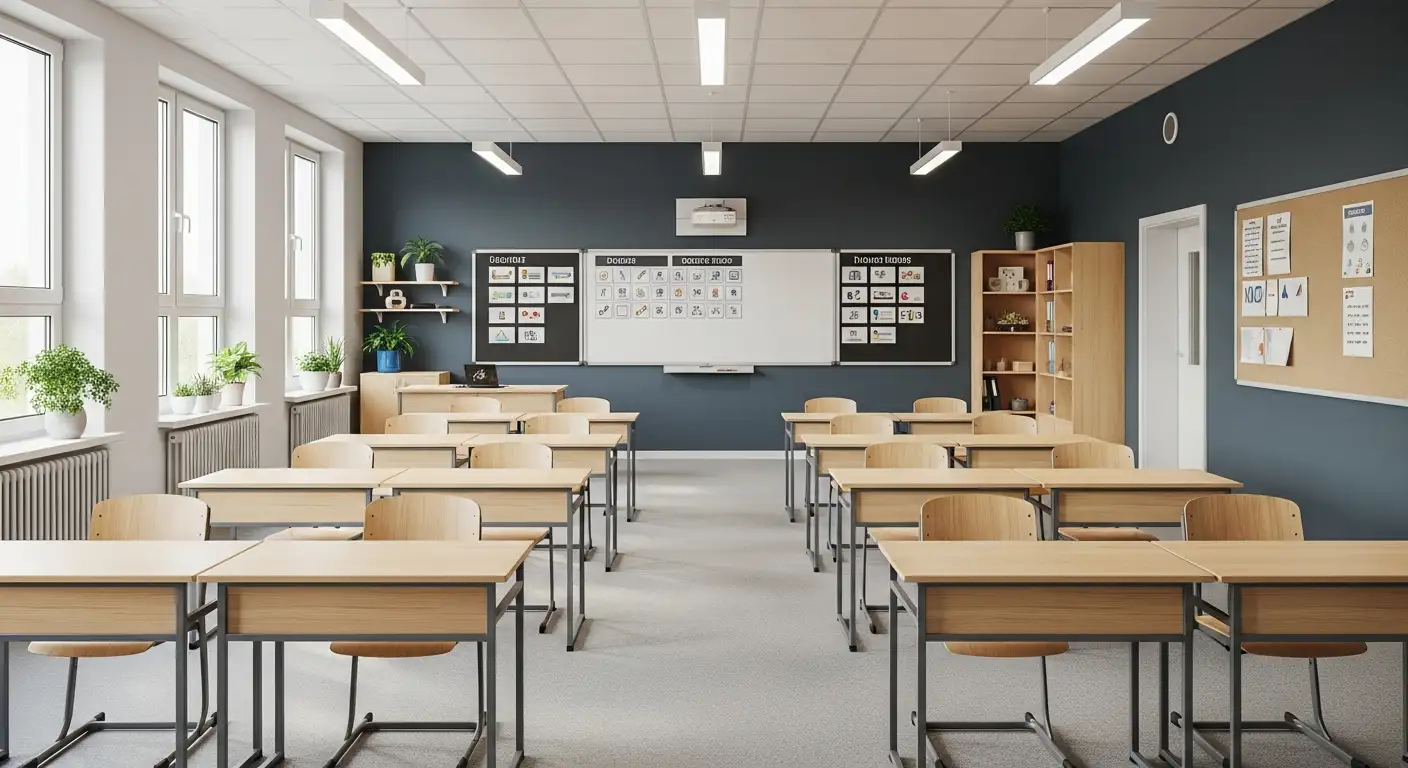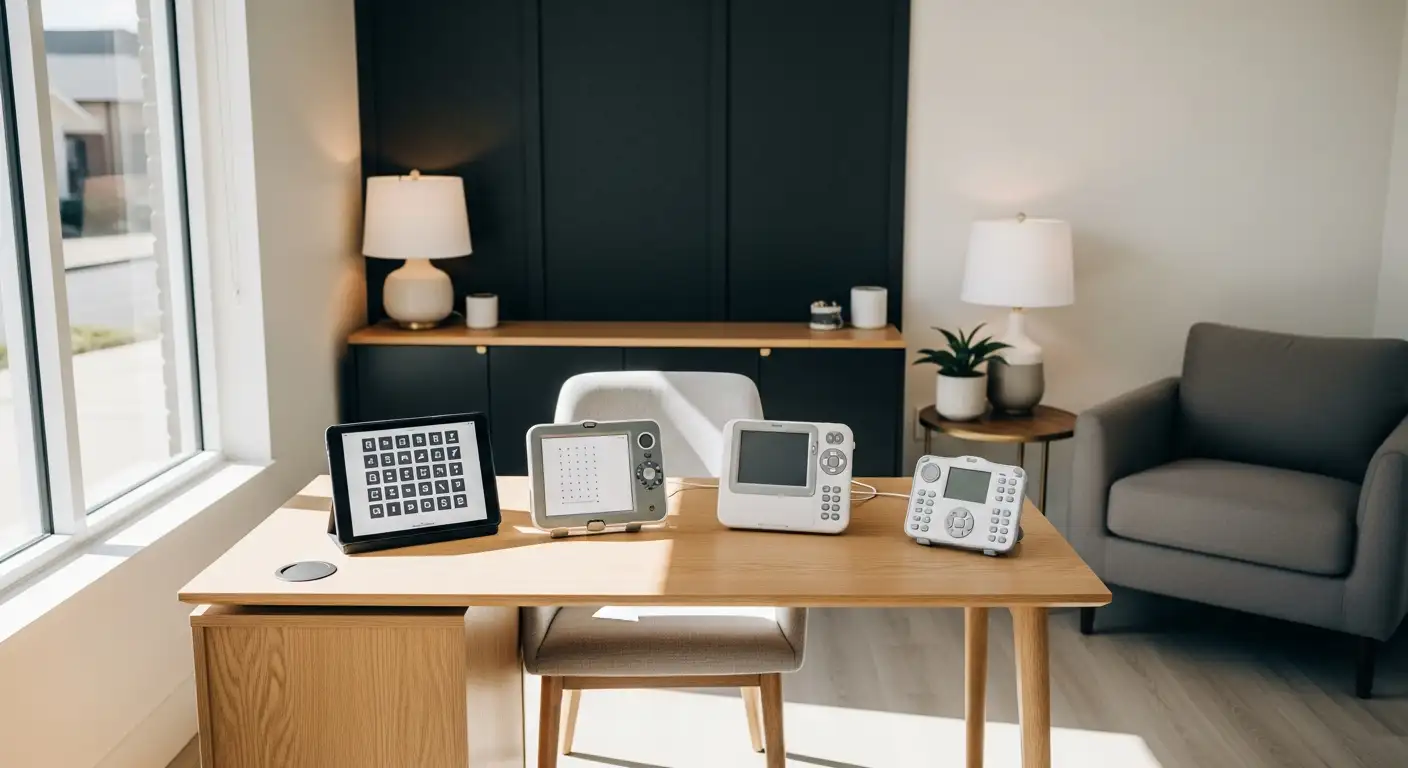Facial Grimacing in Autism


Decoding Facial Grimacing in Autism
Facial grimacing is a common nonverbal expression observed in individuals with autism spectrum disorder (ASD), reflecting a complex interplay of neurological, behavioral, and sensory factors. This article explores the nature of facial grimacing within autism, its implications for daily functioning and communication, and how various therapy approaches support individuals in managing this and related behaviors to improve quality of life.
What Is Facial Grimacing in Autism and Why Does It Occur?

What is facial grimacing in autism?
Facial grimacing in autism describes unusual or involuntary facial movements such as frowns, ticks, or tense expressions. These are not deliberate but often signal underlying discomfort or sensory overload experienced by the individual.
Why do individuals with autism exhibit facial grimacing?
Such expressions may result from neurological differences that affect motor control and sensory processing. Many autistic individuals face challenges with regulating emotions, which can manifest through facial expressions like grimacing. It can also be a behavioral reaction to feelings of anxiety, frustration, or overwhelming sensory input.
How are sensory sensitivities and emotional states connected to facial grimacing?
Sensory sensitivities common in autism—such as hypersensitivity to sounds, lights, or touch—can cause discomfort that leads to facial grimacing. These expressions may act as visible signs of emotional distress or attempts to cope with a challenging environment. Understanding these links helps caregivers and therapists tailor supportive strategies, including occupational therapy, to address sensory processing and motor control difficulties.
Sensory Processing and Its Role in Facial Grimacing

How does sensory processing affect facial grimacing in children with autism?
Sensory sensitivities are common in children with autism and can include hypersensitivity to touch, sounds, or visual stimuli. When these children experience overstimulation, it often results in facial expressions such as grimacing. This grimacing acts as a nonverbal signal indicating discomfort or a need to regulate sensory input.
Sensory sensitivity and integration
Sensory processing involves how the nervous system perceives and responds to sensory information. In autism, sensory integration challenges can make normal environmental stimuli feel overwhelming. Difficulties in processing tactile, auditory, or visual inputs contribute to heightened anxiety and stress, often expressed through motor responses like facial grimacing.
Impact on motor responses
Overstimulation from sensory input affects motor control, leading to involuntary reactions such as grimacing. These motor responses are the body's attempt to cope with or communicate sensory overload. Facial grimacing can be seen as a protective mechanism to shield the child from further discomfort.
Relationship to occupational therapy
Occupational therapy (OT) plays a vital role in addressing sensory processing difficulties. OT practitioners assess sensory awareness and develop strategies to improve sensory integration, helping children better manage their responses. Interventions such as sensory integration therapy target reducing hypersensitivity, which can reduce facial grimacing and enhance participation in daily activities. OT approaches also focus on creating achievable goals that promote independence and comfort.
By addressing sensory sensitivities through tailored occupational therapy, children with autism can experience less sensory overload, resulting in fewer distress signals like facial grimacing and improved overall well-being.
Behavioral and Communication Therapies Addressing Facial Grimacing
How do therapies like ABA address facial grimacing in autism?
Applied Behavior Analysis (ABA) directly targets behaviors such as facial grimacing by breaking complex skills into smaller, manageable steps. Through consistent positive reinforcement, ABA encourages children to replace non-adaptive facial expressions with healthier ways of showing emotion or signaling discomfort. This approach supports the development of more functional communication patterns, helping children express themselves more clearly and reducing stress-related or involuntary grimacing.
What role does speech therapy play in managing nonverbal behaviors like facial grimacing?
Speech therapy expands communication abilities beyond words, focusing also on nonverbal signals. Therapists work with children to enhance their understanding and use of facial expressions, gestures, and other body language. For children struggling with verbal communication, speech therapy often incorporates augmentative and alternative communication (AAC) methods. These tools enable children to convey their needs and feelings effectively, decreasing the need to rely on involuntary expressions such as facial grimacing.
Behavioral interventions for managing facial grimacing
Behavioral therapies, especially those based on ABA principles, use structured intervention to understand the triggers and functions of facial grimacing. By identifying why a child grimaces—whether due to sensory discomfort, anxiety, or communication attempts—therapists develop personalized strategies. These include teaching alternative behaviors, using reinforcement to encourage positive social expressions, and gradually reducing unwanted grimacing. Collaboration with speech therapists and occupational therapists further supports a comprehensive approach to improving social communication and comfort.
Combining ABA and speech therapy fosters a holistic strategy for addressing facial grimacing, enhancing both behavioral regulation and expressive skills for children with autism.
Occupational and Physical Therapy Contributions

How does occupational therapy help with facial grimacing?
Occupational therapy (OT) plays an important role in helping children with autism manage facial grimacing by focusing on sensory regulation and fine motor control. OT addresses sensory sensitivities that might contribute to involuntary facial movements, helping children better process and respond to sensory input. By enhancing fine motor skills through targeted activities, children gain improved control over small muscle groups, including those involved in facial expressions. Furthermore, occupational therapy supports self-care tasks such as grooming and eating, which require coordination of facial muscles and increase awareness of facial movements. This improved sensory and motor function often results in a reduction of facial grimacing and other involuntary expressions.
What is the role of physical therapy related to facial expressions?
Physical therapy (PT) primarily targets gross motor development, coordination, balance, and posture. While PT does not directly focus on facial muscles, enhancing overall body awareness and muscle control can have a positive effect on facial expressions. Improved posture and muscle tone through physical therapy reduce muscular tension that may extend to the face, thereby lessening facial grimacing caused by stress or discomfort. Adaptive equipment and exercises taught in PT help children maintain calm, coordinated movements, which indirectly supports smoother and more controlled facial expressions.
Improving motor control and sensory regulation
Both occupational and physical therapy contribute to better motor control and sensory regulation in children with autism. OT focuses on fine motor skills and sensory processing, guiding children to manage sensory overload and improve precise muscle movements. PT complements this by developing large muscle groups and enhancing overall motor coordination. Together, these therapies form a comprehensive approach that supports improved facial muscle control and reduces involuntary grimacing.
Fine and gross motor skills relation to facial expressions
Fine motor skills involve small muscle movements, such as those in the hands and face, which are essential for speech and facial expressions. Gross motor skills relate to larger body movements but impact posture and muscle tone throughout the body. Good gross motor control from PT supports stable posture, thus reducing tension in facial muscles. Meanwhile, OT’s focus on fine motor control supports nuanced facial movements, allowing children to express emotions and communicate more effectively.
Therapy techniques reducing facial grimacing
Therapists use a variety of techniques to reduce facial grimacing. Occupational therapy may incorporate sensory integration activities and oral motor exercises to develop better muscle tone and sensory awareness in the face and mouth. Physical therapy includes balance and coordination exercises that decrease overall muscular tension, indirectly benefiting facial muscles. Both therapies emphasize consistent, individualized goal-setting and progress monitoring to achieve functional improvements in facial muscle control.
The Importance of a Multidisciplinary, Individualized Approach

Why is a multidisciplinary approach critical for addressing facial grimacing in autism?
Addressing complex behaviors such as facial grimacing in children with autism requires a coordinated team effort. Applied Behavior Analysis (ABA) targets behavioral triggers and develops adaptive social and communication skills. Occupational therapy (OT) evaluates sensory processing issues that may underlie discomfort expressed through facial grimacing. Speech therapy assists in enhancing communication, helping children express needs without resorting to nonverbal distress signals. Physical therapy (PT) supports any motor control factors affecting facial muscle movements. Together, these therapies form a holistic approach that tackles the behavioral, sensory, communicative, and motor components linked to facial grimacing, increasing the chances of meaningful progress.
How does individualization and family involvement improve therapy outcomes?
Personalizing therapy to the child’s specific strengths and challenges ensures that goals are realistic and relevant, promoting better engagement and skill acquisition. Therapies that involve families empower them to be active participants, reinforcing strategies across daily routines. Monitoring progress through goal-setting and evaluation allows adjustments to interventions, keeping therapy dynamic and responsive. This approach nurtures a consistent support system that bridges clinical and home environments, which is essential for sustained improvements and generalization of skills to everyday life.
Collaboration among therapy disciplines
Effective therapy programs depend on open communication among ABA therapists, occupational therapists, speech-language pathologists, and physical therapists. This team collaboration ensures that each child receives consistent messaging and cohesive activities that complement each other, avoiding contradictory approaches. Combined efforts facilitate progress in multiple developmental domains simultaneously, fostering comprehensive growth.
Tailoring interventions to each child
Every child with autism presents unique profiles of abilities and challenges. Therapies are customized based on thorough assessments to address sensory sensitivities, communication needs, behavioral concerns, and motor skills. Individualized plans promote achievable milestones and accommodate changes over time, maximizing developmental potential.
Family involvement and progress measurement
Families are invaluable partners in therapy, as their involvement promotes generalization of skills beyond clinical settings. Parent training empowers caregivers to apply techniques at home, enhancing consistency. Regular progress measurement through specific goals enables adjustments to be made and celebrates achievements, motivating continued engagement.
| Therapy Discipline | Role in Intervention | Contribution to Addressing Facial Grimacing |
|---|---|---|
| Applied Behavior Analysis (ABA) | Behavior modification, positive reinforcement | Reduces maladaptive behaviors causing grimacing |
| Occupational Therapy (OT) | Sensory processing, fine motor and daily living skills | Addresses sensory triggers and motor control |
| Speech Therapy | Communication skills, AAC support | Provides alternative ways to express discomfort |
| Physical Therapy (PT) | Gross motor skills, coordination | Supports motor aspects of facial movements |
Complementary Therapies and Innovative Interventions
What complementary therapies help manage facial grimacing and related symptoms?
Complementary therapies such as sensory integration therapy, music therapy, and hippotherapy offer supportive benefits for children with autism, especially in managing symptoms like facial grimacing.
Sensory integration therapy focuses on helping children process and respond to sensory information more effectively. By promoting sensory balance, this therapy can reduce discomfort that sometimes results in facial grimacing.
Music therapy uses structured musical activities to improve emotional regulation and relaxation. Engaging with music can soothe anxiety and help children express emotions nonverbally, which may reduce involuntary facial movements.
Hippotherapy involves therapeutic horseback riding and leverages rhythmic movement to enhance motor skills and sensory processing. This activity encourages balance and calmness, potentially minimizing expression-related symptoms.
Emotional development therapies
Emotional development therapies, including DIR/Floortime and Relationship Development Intervention (RDI), emphasize play-based and relationship-centered approaches. These therapies nurture emotional growth and flexible thinking, supporting better self-regulation and social connectedness.
When combined, these complementary and innovative therapies create a holistic framework that addresses both sensory and emotional challenges. This integrated approach fosters relaxation and motor control, offering pathways to reduce facial grimacing and enhance overall wellbeing.
Early Intervention and Long-Term Outlook

Why is early therapy important in managing facial grimacing in autism?
Early therapy, especially before the age of three, takes advantage of the brain's high plasticity during early development. This heightened adaptability allows interventions to more effectively establish control over sensory, motor, and behavioral responses—including facial grimacing. Early occupational and behavioral therapies can help regulate and reduce these involuntary expressions by improving motor skills and emotional regulation, setting a foundation for better self-control and social interaction later on.
Can therapy still be beneficial beyond early childhood?
Therapeutic interventions retain their value well beyond early childhood. Although earlier intervention is ideal, individuals of all ages can benefit from ongoing therapy to adapt and enhance skills. Speech therapy, occupational therapy, and applied behavior analysis continue to support improvements in communication, motor control, emotional expression, and behavior management. Lifelong therapy helps maintain and build upon previously acquired skills, promoting greater independence and improved quality of life.
Benefits of Early Therapy
Early intervention encourages faster and more comprehensive progress in multiple developmental areas. It aids in developing communication, social interaction, motor skills, and emotional regulation. Combined therapies create a collaborative approach that reinforces gains across interpersonal and functional skills.
Brain Plasticity
Brain plasticity refers to the brain’s ability to change and reorganize through experience and learning. It is most pronounced in early childhood, making early therapy a critical window for influencing neural pathways linked to behavior and sensory processing.
Lifelong Management and Adaptability
Autism symptoms and challenges evolve, so therapy is often a lifelong process adapting to new needs. Tailored interventions throughout life ensure continued personal growth, helping individuals handle new social situations, develop independence, and improve mental health.
| Aspect | Early Intervention | Later Therapy Benefits |
|---|---|---|
| Target Age Group | Primarily before age 3 | All ages |
| Focus Areas | Brain plasticity, sensory regulation, motor control | Skill refinement, adapting to life changes |
| Outcome | Establish foundational developmental skills | Maintain and improve independence |
| Therapy Examples | ABA, occupational therapy, speech therapy | Cognitive behavioral therapy, social skills training |
Integrating Therapies to Support Nonverbal Expression in Autism
Facial grimacing in autism reflects a multifaceted challenge rooted in neurological, sensory, emotional, and behavioral domains. A comprehensive, multidisciplinary therapy approach that includes Applied Behavior Analysis, occupational, speech, and physical therapies, complemented by sensory and emotional regulation techniques, offers the best path toward managing these expressions. Early and individualized intervention, with active family involvement, significantly enhances an individual's ability to communicate effectively and engage socially. Understanding and supporting the underlying causes of facial grimacing not only improves personal comfort and communication but also fosters greater independence and quality of life for individuals with autism.
References
Recent articles

The Benefits of ABA Therapy for Sibling Relationships and Family Bonds
Strengthening Family Ties Through Applied Behavior Analysis

How Speech Therapy Assists with Improving Verbal and Nonverbal Communication
Unlocking Communication Potential: The Role of Speech Therapy

Supporting Autism During Transitions
Strategies and Therapies to Navigate Transitions for Children with Autism

Low-Functioning Autism
Understanding Support and Therapies for Autism Spectrum Disorder Level 3

How Speech Devices Enhance Communication for Nonverbal Children
Transforming Communication: The Role of Speech Devices for Nonverbal Children

TEACCH Method For Autism
Comprehensive Therapeutic Approaches for Autism Spectrum Disorder


